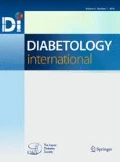Abstract
Abstract
A number of studies have reported the usefulness of monitoring skin temperature at local points in reducing the risk of ulceration. Thermography has the advantage of being able to visualize morphological temperature distribution. We reported that inflammation was detected by thermography in 10% of diabetes mellitus (DM) patients with foot calluses, and the area in which increased skin temperature was observed was limited to the callus. However, no reports have described thermographic findings of calluses deteriorating into foot ulcers. We report a case monitoring the skin temperature distribution using thermography, which might be useful for predicting ulceration.
Case
A 53-year-old male patient, diagnosed with type 2 DM, was treated with insulin therapy. The duration of DM was 4 years. He was also diagnosed with dyslipidemia and hypertension. Using thermography, the skin temperature was evaluated in the patient with calluses on the 5th metatarsal heads. Areas of increased skin temperature were observed, involving not only the callused part, but also the plantar arch. We shaved his calluses once a month and explained the importance of his therapeutic shoes to prevent the ulcers. After 43 months, an ulcer developed.
Discussions
Thermographic findings of an extended area of increased skin temperature not limited to the callus may suggest the progression of a callus to ulcer. Expansion of the area of increased skin temperature might show the inflammation or infection extending along the fascia. Based on these findings, thermography could provide a useful assessment of callus in DM patients with a high risk of progression.



Similar content being viewed by others
References
Frykberg RG, Zgonis T, Armstrong DG, Driver VR, Giurini JM, Kravitz SR, Landsman AS, Lavery LA, Moore JC, Schuberth JM, Wukich DK, Andersen C, Vanore JV. Diabetic foot disorders. A clinical practice guideline (2006 revision). J Foot Ankle Surg. 2006;45(5):S1–66.
Resnick HE, Carter EA, Lindsay R, Henly SJ, Ness FK, Welty TK, Lee ET, Howard BV. Relation of lower-extremity amputation to all-cause and cardiovascular disease mortality in American Indians: the Strong Heart Study. Diabetes Care. 2004;27(6):1286–93.
Ragnarson Tennvall G, Apelqvist J. Health-related quality of life in patients with diabetes mellitus and foot ulcers. J Diabetes Complicat. 2000;14:235–41.
Nabuurs-Franssen MH, Huijberts MS, Nieuwenhuijzen Kruseman AC, Willems J, Schaper NC. Health-related quality of life of diabetic foot ulcer patients and their caregivers. Diabetologia. 2005;48:1906–10.
International diabetes federation. The IDF diabetes Atlas (the 7th edition). 2015.
Armstrong DG, Holtz-Neiderer K, Wendel C, Mohler MJ, Kimbriel HR, Lavery LA. Skin temperature monitoring reduces the risk for diabetic foot ulceration in high-risk patients. Am J Med. 2007;120(12):1042–6.
Lavery LA, Higgins KR, Lanctot DR, Constantinides GP, Zamorano RG, Athanasiou KA, Armstrong DG, Agrawal CM. Preventing diabetic foot ulcer recurrence in high-risk patients: use of temperature monitoring as a self-assessment tool. Diabetes Care. 2007;30(1):14–22.
Lavery LA, Higgins KR, Lanctot DR, Constantinides GP, Zamorano RG, Armstrong DG, Athanasiou KA, Agrawal CM. Home monitoring of foot skin temperatures to prevent ulceration. Diabetes Care. 2004;27(11):2642–7.
Nishide K, Nagase T, Oba M, Oe M, Ohashi Y, Iizaka S, Nakagami G, Kadowaki T, Sanada H. Ultrasonographic and thermographic screening for latent inflammation in diabetic foot callus. Diabetes Res Clin Pract. 2009;85(3):304–9.
Roback K, Johansson M, Starkhammar A. Feasibility of a thermographic method for early detection of foot disorders in diabetes. Diabetes Technol Ter. 2009;11(10):663–7.
Nagase T, Sanada H, Takehara K, Oe M, Iizaka S, Ohashi Y, Oba M, Kadowaki T, Nakagami G. Variations of plantar thermographic patterns in normal controls and non-ulcer diabetic patients: novel classification using angiosome concept. J Plast Reconstr Aesthet Surg. 2011;64(7):860–6.
Oe M, Yotsu RR, Sanada H, Nagase T, Tamaki T. Thermographic findings in a case of type 2 diabetes with foot ulcer and osteomyelitis. J Wound Care. 2012;21(6):274–8.
Oe M, Yotsu R, Sanada H, Nagase T, Tamaki T. Screening for osteomyelitis using thermography in patients with diabetic foot. Ulcers. 2013. doi:10.1155/2013/284294.
Yavuz M, Brem RW, Davis BL, Patel J, Osbourne A, Matassini MR, Wood DA, Nwokolo IO. Temperature as a predictive tool for plantar triaxial loading. J Biomech. 2014;47(15):3767–70.
Author information
Authors and Affiliations
Corresponding author
Ethics declarations
Conflict of interest
T. Yamauchi received a scholarship Grant from Sanofi. M. Oe, K. Takehara, H. Noguchi, Y. Ohashi, A. Amemiya, H. Sakoda, R. Suzuki, K. Ueki, T. Kadowaki, and H. Sanada declare that they have no conflict of interest.
Ethical standards
All procedures followed were in accordance with the ethical standards of the responsible committee on human experimentation (institutional and national) and with the Helsinki Declaration of 1964 and later versions. Informed consent or a substitute for it was obtained from the patient for being included in the study.
About this article
Cite this article
Oe, M., Takehara, K., Noguchi, H. et al. Thermographic findings in a case of type 2 diabetes with foot ulcer due to callus deterioration. Diabetol Int 8, 328–333 (2017). https://doi.org/10.1007/s13340-017-0315-1
Received:
Accepted:
Published:
Issue Date:
DOI: https://doi.org/10.1007/s13340-017-0315-1




